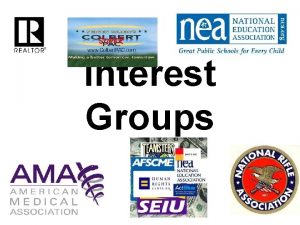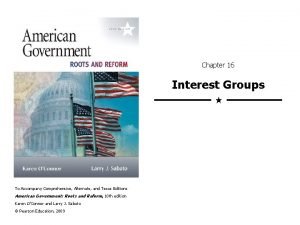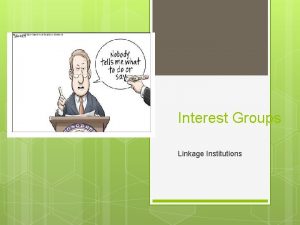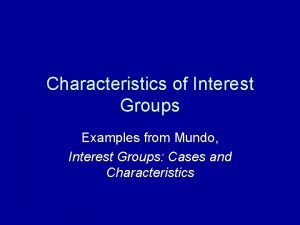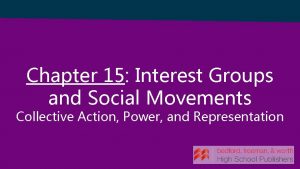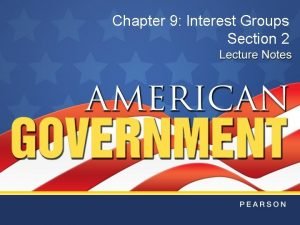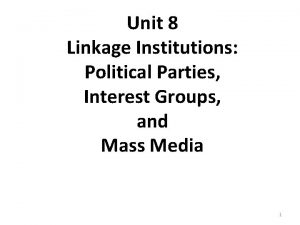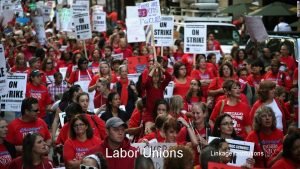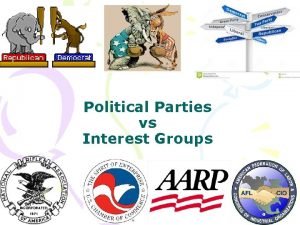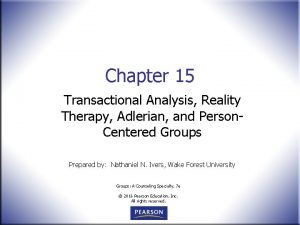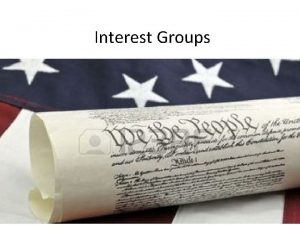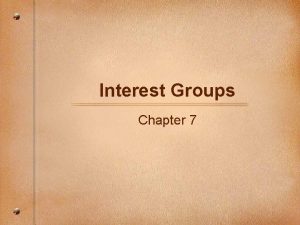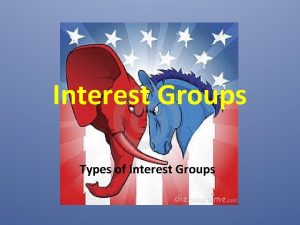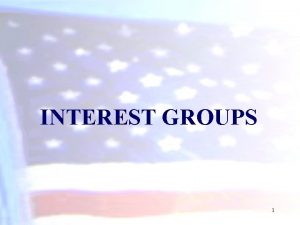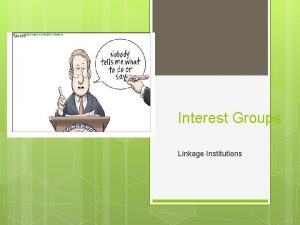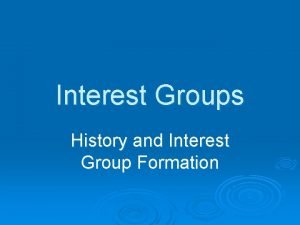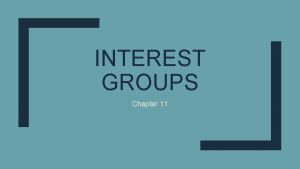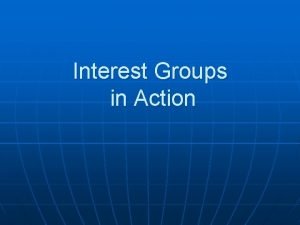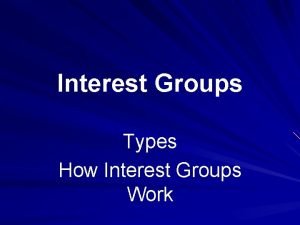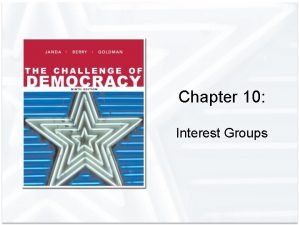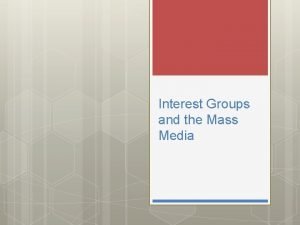Interest Groups The interest group universe Interest group


















































- Slides: 50

Interest Groups

The interest group universe • Interest group: An organization of people who share common political interests and aim to influence public policy by electioneering and lobbying. • Lobbying: Efforts to influence public policy through contact with public officials on behalf of interest groups. • Interest groups are organizations that seek to influence government policy by helping to elect candidates who support the organizations policy goals and by lobbying elected officials and bureaucrats.

The interest group universe Three critical differences between interest groups and political parties: 1. Political parties focus on running candidates for office and coordinating the activities of elected officials. 2. Major political parties guaranteed positions on electoral ballots.

The interest group universe 3. Elected members of political parties have a direct influence over government activity: they propose, debate and vote on policies. Interest groups have only indirect influence – they must persuade elected officials to support their goals or help elect candidates who already share their goals.

Interest group universe Interest groups may be primarily political organizations such as • Public Citizen – conducts research projects, lobbies legislators and bureaucrats, tries to rally public opinion on a range of environmental, health and energy issues.

Interest group universe Lobbying may be only part of what an interest group does: • National Rifle Association (NRA) endorses candidates, contributes to campaigns and lobbies elected officials. But also runs gun safety classes, holds competitions and sells “hardware” to members.

Interest group universe For some organizations, interest group activity is almost hidden: • American Automobile Association (AAA) known as a provider of roadside assistance and maps, but also is an interest group: lobbies for more highway funds and less funding for mass transit.

Types of interest groups: Public Interest groups Public interest groups seek a collective good that will not selectively and materially benefit group members. • Civil liberties groups: ACLU; NAACP; LULAC • Environmental groups- Sierra Club; Nature Conservancy; Audubon Society • Advocacy groups: Children’s Defense Fund; NAMI (National Alliance on Mental Illness) • Good Government groups: Common Cause; Public Citizen; • Animal welfare organizations: SPCA, Humane Society

Public Interest groups • • • https: //www. aclu. org/ http: //www. sierraclub. org/ http: //www. childrensdefense. org http: //www. commoncause. org/ http: //www. humanesociety. org/

Types of Interest Groups : Economic interest groups Primary purpose of economic interest groups is promoting the financial interests of its members • Labor unions: American Federation of State County and Municipal Employees --AFSCME; Communication Workers of America -- CWA; AFLCIO (federation of 56 unions) • Trade associations and Business groups: National Association of Manufacturers; U. S. Chamber of Commerce • Professional organizations: American Medical Association; American Bar Association

Economic interest groups • http: //www. cwa-union. org/about • https: //www. uschamber. com/about-us/about -the-us-chamber • http: //www. amaassn. org/ama/pub/advocacy/federaladvocacy. page?

Resources The resources that interest groups need to support their lobbying efforts are • People (members), • Money • Expertise People: group members can write to or meet with their elected officials They can travel to Washington, DC for demonstrations.

Resources Money: Virtually everything an interest group does, from meeting with elected officials to fighting for what they want in court can be purchased as services. • Money is necessary to fund the group’s everyday operations. • Well-funded groups can hire experts, lobbyists and lawyers and develop and run campaign ads.

Resources Expertise: can take many forms. Interest groups may offer legislators reports on policy questions They may even draft legislative proposals for them.

Resources • Expertise also can involve knowledge of political factors such as what kinds of policies certain legislators support or information about the constitutionality of proposed laws. • Lobbying firms that employ former members of Congress, former congressional aides and former bureaucrats are good sources of this kind of expertise. (known as the “revolving door”)

Business of Lobbying • More than $3. 1 billion was spent on lobbying in 2016. This money was spent by 11, 143 lobbyists working for corporations, labor unions and individuals to lobby members of the U. S. Congress and federal agencies. https: //www. opensecrets. org/lobby/incdec. php • The U. S. Chamber of Commerce spent the most on lobbying in 2016: $103, 950, 000 ; https: //www. opensecrets. org/lobby/top. php? sh ow. Year=2016&index. Type=s

Business of lobbying Companies may lobby through membership in trade associations – an interest group composed of companies in the same industry that lobbies for policies that benefit members of the group. National Beer Wholesalers Association (NBWA), nationwide group of businesses that buy beer from brewers and resell it to stores and restaurants.

Business of lobbying • NBWA principle lobbying goal is to ensure that laws remain in place requiring middlemen between producers of beer and the stores, bars, and restaurants that sell beer to consumers. • If rules were to change, NBWA members would be out of a job. • https: //www. brewersassociation. org/govern ment-affairs/ba-position-statements/

Interest group strategies: inside strategies Interest group strategies can include: • direct lobbying • drafting legislation and regulations • research • testifying at hearings • litigation • working together with other interest groups toward achieving a specific outcome known as “inside strategies” because they are actions taken in Washington DC.

Inside strategies: direct lobbying Direct lobbying: attempts by interest group staff to influence policy by speaking with elected officials or bureaucrats. • Direct lobbying is usually aimed at officials and bureaucrats who are sympathetic to the group’s goals. • Interest groups help like-minded legislators to secure policy changes they both want. • Help can range from sharing information to drafting legislative proposals or regulations.

Inside strategies: direct lobbying In direct lobbying efforts an interest group will contact: • elected officials, • members of the president’s staff, • bureaucrats in the executive branch (bureaucrats are non-elected officials; employees working in the various bureaus, boards, agencies and commissions in the executive branch of government known as the Federal Bureaucracy. ) The executive branch is tasked with enforcing federal laws and so certain high level bureaucrats oversee the enforcement of federal laws and regulations.

Inside strategies: direct lobbying Different officials play distinct roles in the policy-making process • Members of Congress shape legislation and budgets. • Presidential staff members influence policymaking. • Executive branch bureaucrats change the ways regulations are written and implemented and enforced

Inside strategies: drafting legislation and regulations Interest groups sometimes draft legislative proposals and regulations which they deliver to members of Congress and executive branch bureaucrats. • Interest groups don’t just give such proposals to anyone. • Seek out legislators both sympathetic to their cause and who have significant influence in Congress.

Inside strategies: drafting legislation and regulations • Example: A lobbying effort aimed at cutting student loan interest rates would target members of congressional committees with jurisdiction over student loans – preferably the committee chair or subcommittee chair.

Inside strategies: drafting legislation and regulations Interest groups also lobby bureaucrats to influence details of new regulations. • If the regulation involved can be put into effect without congressional approval, lobbying bureaucrats in this matter can achieve the group’s desired goal.

Inside strategies: Research Interest groups often prepare research reports that may sway public opinion or help persuade elected officials or bureaucrats. • Research enables an interest group to claim expertise that enhances the groups credibility with members of Congress as well as the media. • EX: Public Citizen features research reports on its website http: //www. citizen. org/Page. aspx? pid=524

Inside strategies: Hearings • Interest group staff may testify at Congressional hearings. • This activity is intended to inform members of Congress about issues that matter to the interest group. NRA testifies at Senate hearing, 2013 – background checks at gun shows: https: //www. youtube. com/watch? v=OSHzgt 0 n 3 w

Inside strategies: litigation Interests groups can use litigation (the process of taking legal action) by taking the government to court if the group claims government actions are not consistent with the Constitution or that the government has misinterpreted an existing law. • Interest groups can also get involved in an existing court case by filing amicus curiae (friend of the court) briefs in cases relevant to the group’s goals.

Inside strategies: litigation • An amicus curiae brief shows the court the group’s rationale for how they want the judges to decide the case. • Amicus curiae briefs are a way to lobby the judicial branch of government.

Inside strategies: litigation In the 2010 case, Mc. Donald V. City of Chicago, which established a constitutional right to individual gun ownership in the U. S. , amicus briefs in support of the petitioner (Mc. Donald) by groups that included: Jews for the Preservation of Firearms Ownership the Maryland Arms Collectors Association California Rifle and Pistol Association Texas Concealed Handguns Association Virginia Citizens Defense League Academics for the Second Amendment Gun Owners of America, Inc. The National Rifle Association and many others

Lobbying the judiciary: supreme court nominations • Conservative groups spent an estimated $10 million advancing the confirmation of Neil Gorsuch to the vacant seat on the U. S. Supreme Court in March, 2017. • http: //progressive. org/dispatches/zephyr-teachout-ongorsuch/ • Liberal groups who opposed Gorsuch confirmation were vastly outspent. • https: //www. washingtonpost. com/politics/senatedemocrats-vastly-outspent-by-right-in-gorsuchfight/2017/03/18/1 c 42 c 3 e 2 -0 b 39 -11 e 7 -93 dc 00 f 9 bdd 74 ed 1_story. html? utm_term=. 76 c 767 fab 40 b

Outside strategies Lobbying efforts that take place outside of Washington are known as outside strategies. Outside strategies include: • Grassroots lobbying • Electioneering • Cultivating media contacts

Outside strategies: grassroots lobbying Grassroots lobbying is a lobbying strategy that relies on participation by group members, such as protest or a letter writing campaign. • Grassroots strategies are useful because elected officials seldom want to act against a large group of citizens who care enough about an issue to express their position. • http: //www. aspca. org/take-action/advocacycenter

Outside strategies: grassroots lobbying • Grassroots strategies are effective only for groups with large numbers of members • legislators are not likely to pay attention to a letter-writing campaign unless several thousand pieces of /email reach them on an issue. • if a legislator receives 10, 000 emails, all with the same wording, the effort may be dismissed by the legislator as Astroturf lobbying

Outside strategies: grassroots lobbying Astroturf lobbying: a term used by Washington congressional staffers for a lobbying method initiated by an interest group that is designed to look like spontaneous, independent participation of many individuals.

Outside strategies: electioneering Interest groups get involved in elections by: • Making contributions to candidates • Endorsing candidates • Funding campaign ads • Mobilizing supporters for a candidate or a party • These efforts seek to influence who gets elected with the expectation that changing who gets elected will affect what the government does.

Outside strategies: electioneering • What an interest group can and cannot do to influence elections is limited by federal election laws. • Groups that want to engage in lobbying or electioneering can incorporate and operate as a political action committee (PAC) or a 527 organization.

Outside strategies: electioneering • PAC: an interest group or a division of an interest group that can raise money to contribute to campaigns or to spend on campaign ads in support of candidates. • The amount a PAC can receive from each of its donors and the amount it can spend on federal campaigning are strictly limited. • https: //www. opensecrets. org/pacs/

Outside strategies: electioneering 527 organization: a tax-exempt group formed primarily to influence elections through voter mobilization efforts and issue ads that do not directly endorse or oppose a candidate. • Unlike PACs, 527 s are not subject to contribution limits and spending caps. https: //www. opensecrets. org/527 s/527 cmtes. p hp? level=C

Outside strategies: electioneering Two new options for electioneering for interest groups emerged in 2010: “Super Pacs” and 501(c) (4) organizations. • Super Pacs emerged as a consequence of the Citizens United Supreme Court decision that authorized unlimited independent spending by corporations and labor unions in federal elections. • https: //www. washingtonpost. com/graphics/polit ics/2016 -election/campaign-finance/

Outside strategies: electioneering • Unlike traditional PACs, super PACs are prohibited from donating money directly to political candidates, and their spending must not be coordinated with that of the candidates they benefit. • “super” label reflects the fact that these groups take in and spend much more than the typical PAC. https: //www. opensecrets. org/pacs/superpacs. ph p? cycle=2016

Outside strategies: electioneering • Because many businesses prefer that their contributions remain secret – they don’t want to anger or alienate shareholders or customers – • they are able to donate through 501 (c) (4) groups that do not have to disclose their donors. 501(c)(4) groups are commonly called "social welfare" organizations that may engage in political activities, as long as these activities do not become their primary purpose. https: //www. opensecrets. org/527 s/types. php

Summary: Four types of campaign finance organizations Political Action Committees (PACs): An interest group (or a division of an interest group) that can raise money to contribute to campaigns or to spend on ads in support of candidates. The amount a PAC can receive from each of its donors and the amount it can spend in federal elections are strictly limited.

Summary: Four types of campaign finance organizations 527 organization: A tax-exempt group formed primarily to influence elections through voter mobilization efforts and issue ads that do not directly endorse or oppose a candidate. Unlike PACs, they are not subject to contribution limits and spending caps.

Summary : Four types of campaign finance organizations • Super. Pacs: Created as a result of the 2010 Citizens United decision, Super. Pacs are independent, expenditure only committees that may raise unlimited sums from corporations, labor unions, non-profit organizations and individuals and spend these sums to support or oppose political candidates. • Super. Pacs may not donate directly to a candidate nor coordinate their activities with a candidate or his/her campaign.

Electioneering: Four types of campaign finance organizations • 501(c)(3) organization: A tax code classification that applies to most interest groups; this designation makes donations to the group tax-deductible but limits the group’s political activities.

Electioneering: types of campaign finance organizations 501(c)(4) organization: A non-profit “social welfare” organization whose primary purpose cannot be political; their primary purposes must be to promote social welfare. • These organizations may raise and spend unlimited amounts on electioneering but they cannot coordinate their activities with candidates or parties. • These organization do not have to disclose their donors.

Electioneering: types of campaign finance organizations • The vast majority of interest groups don’t have the resources to influence elections like the Big Spenders. • These smaller interest groups give modest help to candidates who are sympathetic to the group’s goals. • These groups hope that once elected the candidate will remember their contribution when the group asks for a meeting.

Outside strategies: Media contacts • Media coverage can help a group publicize its concerns without spending any money. • Media reports may mobilize public opinion indirectly by getting people to join the group, contribute money, or pressure an elected official to support the group’s cause. • Favorable media coverage also can prove to a group’s membership that its leaders are actively working on the members concerns.

Outside strategies: Media contacts • Smart interest group leaders make it easy for journalists to cover their cause by holding events that produce intriguing news stories. • For the cost of sending out a press release, media coverage provides almost free publicity for the group’s policy agenda.
 How are ethnic groups and religious groups related
How are ethnic groups and religious groups related Free rider problem interest groups
Free rider problem interest groups The nature of interest groups
The nature of interest groups For or against
For or against A virtue of interest groups is that
A virtue of interest groups is that Interest groups linkage institutions
Interest groups linkage institutions Proliferation of interest groups
Proliferation of interest groups State two characteristics of interest groups
State two characteristics of interest groups Interest groups vs social movements
Interest groups vs social movements Chapter 9 section 2 types of interest groups
Chapter 9 section 2 types of interest groups Definition of linkage institutions
Definition of linkage institutions Linkage institutions
Linkage institutions Federalist 10 interest groups
Federalist 10 interest groups What are interest groups
What are interest groups Fundamental goal of interest groups
Fundamental goal of interest groups Group leaders of reality therapy groups are
Group leaders of reality therapy groups are Hình ảnh bộ gõ cơ thể búng tay
Hình ảnh bộ gõ cơ thể búng tay Ng-html
Ng-html Bổ thể
Bổ thể Tỉ lệ cơ thể trẻ em
Tỉ lệ cơ thể trẻ em Chó sói
Chó sói Tư thế worm breton là gì
Tư thế worm breton là gì Chúa yêu trần thế alleluia
Chúa yêu trần thế alleluia Các môn thể thao bắt đầu bằng từ đua
Các môn thể thao bắt đầu bằng từ đua Thế nào là hệ số cao nhất
Thế nào là hệ số cao nhất Các châu lục và đại dương trên thế giới
Các châu lục và đại dương trên thế giới Công thức tiính động năng
Công thức tiính động năng Trời xanh đây là của chúng ta thể thơ
Trời xanh đây là của chúng ta thể thơ Mật thư tọa độ 5x5
Mật thư tọa độ 5x5 Phép trừ bù
Phép trừ bù Phản ứng thế ankan
Phản ứng thế ankan Các châu lục và đại dương trên thế giới
Các châu lục và đại dương trên thế giới Thơ thất ngôn tứ tuyệt đường luật
Thơ thất ngôn tứ tuyệt đường luật Quá trình desamine hóa có thể tạo ra
Quá trình desamine hóa có thể tạo ra Một số thể thơ truyền thống
Một số thể thơ truyền thống Cái miệng nó xinh thế
Cái miệng nó xinh thế Vẽ hình chiếu vuông góc của vật thể sau
Vẽ hình chiếu vuông góc của vật thể sau Thế nào là sự mỏi cơ
Thế nào là sự mỏi cơ đặc điểm cơ thể của người tối cổ
đặc điểm cơ thể của người tối cổ Thế nào là giọng cùng tên?
Thế nào là giọng cùng tên? Vẽ hình chiếu đứng bằng cạnh của vật thể
Vẽ hình chiếu đứng bằng cạnh của vật thể Fecboak
Fecboak Thẻ vin
Thẻ vin đại từ thay thế
đại từ thay thế điện thế nghỉ
điện thế nghỉ Tư thế ngồi viết
Tư thế ngồi viết Diễn thế sinh thái là
Diễn thế sinh thái là Dot
Dot Số nguyên tố là số gì
Số nguyên tố là số gì Tư thế ngồi viết
Tư thế ngồi viết Lời thề hippocrates
Lời thề hippocrates



